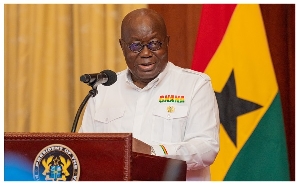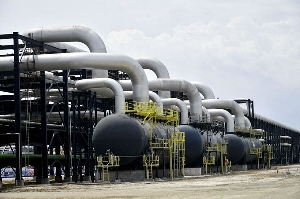- Home - News
- TWI News | TV
- Polls
- Year In Review
- News Archive
- Crime & Punishment
- Politics
- Regional
- Editorial
- Health
- Ghanaians Abroad
- Tabloid
- Africa
- Religion
- Election 2020
- Coronavirus
- News Videos | TV
- Photo Archives
- News Headlines
- Press Release
General News of Monday, 10 December 2007
Source: --
Situation report on floods, Nov 2007
Highlights
- As of 30 November, Ghana Flash Appeal on floods has been funded at 51%.
- Concerns have been raised about the availability of sufficient water in the Northern Region when the CAN 2008 starts.
- Field work for the Emergency Food Need Assessment is underway.
- Consistent reports indicate that teaching and learning is taking place in the affected areas.
Situation Overview
Flooding in the Upper East Region, Upper West Region, Northern Region and parts of the Western Region have affected 332,600 people and caused the death of 56 according to the Government. Some 35,000 houses, 1,500 kilometres of road and thousand hectares of crops have been destroyed. On 9 October an appeal for international assistance was launched by the government for the reconstruction of flood devastated areas.
Humanitarian Response
Food and non food items
The WFP Immediate Response Operation will end on 30 November. It will be followed immediately on 1 December by a five-month Emergency Operation (EMOP) which is intended to provide 75,000 beneficiaries with cereals, vitamin A enriched vegetable oil and iodized salt.
Reports of the Post distribution Monitoring (PDM) that has been conducted in 12 communities in 8 of the flood affected districts, indicate that food commodities have reached 11 communities. However, food distributed to beneficiaries do not last the expected duration of one month since the food items destined to flood victims are shared with their hosts. Nonetheless, the monitoring teams did not observe sales of household items, productive assets or relief food on the markets, which indicates that there are minimal inclusion errors.
Training for enumerators and supervisions for the Emergency Food Need Assessment has been completed for all three regions. Trainees included staff from the Ministry of Food and Agriculture (MOFA), WFP, ADRA, OICI, CARE, CRS. Field work for the assessment started on 21 November, and final report is expected in Mid-December.
Health
Two cases of paralysis have been found which is possibly as a result of poliomyelitis through water contamination. Samples have been sent to Noguchi for confirmation. There are no reports of increase of neither diarrhoea diseases nor pneumonia. However, essential drugs have been pre-positioned for the management of diarrhoea, cholera and malaria. With the onset of the dry season, concern has been expressed by Ghana Health Service (GHS] that there could be an outbreak of meningococcal meningitis. GHS has requested for support from WHO and UNICEF to procure preventive vaccines for Cerebrospinal Meningitis (CSM). A number of Bilhazia (Schistosoma hematobium) cases have been noticed in the Sissala West district. All targeted health facilities have cholera management medicines in stock. Emergency Health Kits are now available in the country and ready for deployment, criteria for the deployment are being negotiated with GHS. This is part of Ghana's portion of emergency health kits that were expected for West Africa. The health kits destined to fight malaria and cholera can cover 30,000 people over a period of 1-2months. Through UNFPA, reproductive health kits are expected to be available by the end of November, health facilities in affected communities have been identified for orientation on the use of the expected equipment. In addition, field visits have identified communities that will need support in the areas of child and reproductive health. Response to these challenges will be coordinated at the regional level. Through the Regional Coordinating Council (RCC), NGO World Vision has donated assorted pharmaceuticals worth US$ 20,000 to the Health Directorate of the Upper East Region (UER) for distribution to health institutions in the region. Major laboratories in the three flood affected regions do not have the relevant reagents. WHO (sector lead) recommends the need to strengthen surveillance in the UER.
Nutrition
The Rapid Malnutrition Assessment Survey got underway simultaneously in all the affected districts in the week of 19 November. Prior to that, all district and regional nutrition officers from GHS, local partners from ACDEP, WFP, OICI and CRS were trained in Mid Upper Arm Circumference (MUAC) measurement and the administration of Plumpy'nuts. The participants also received training on anthropometric measurements. Training was conducted by GHS with funding and technical support from UNICEF.
Distribution of 119 cartons (17,850packets) of Plumpy'nuts Ready-to-use Food (RUF) to malnourished children in all 18 Nutrition Rehabilitation Centres (NRC) in the Northern Region and Upper East Region is ongoing. Instructions and recommendations for using the Plumpy'nuts have been produced for the NRCs, and monitoring forms designed to track consumption. UNICEF and WFP will collaborate on the distribution of Corn Soya Blend to children with moderate malnutrition after the Rapid Assessment Survey is completed.
Education
Verification visits by the Upper East Region Ghana Education Service (GES) office has revealed a total of 39 collapsed classrooms. A similar verification assessment will be carried out as soon as possible for Northern Region and Upper West Region. In addition, a technical assessment for all three regions is required to provide sufficient information on specific damage caused by the floods to each individual school to enable an individual response for rehabilitation, determine the realistic cost estimates to undertake the repairs. Design and cost estimates for emergency pavilions have been prepared and approved by Ministry of Education, Science and Sports (MOESS).
UNICEF has initiated the process to construct some semi-permanent school pavilions from its own resources and the construction is expected to be completed by the end of February 2008. Supply items are being distributed in different schools in Northern Region. They include tarpaulins, hygiene kits and school materials such as exercise books, pencils, pens, erasers. The NGO World Vision has received financial support amounting to US$ 48,939 from World Vision Taiwan to assist the construction of three destroyed Kindergarten Schools in the Talensi-Nabdam District. Furthermore, The World Bank has pledged to provide about US$3million to support the reconstruction of some 70 collapsed schools that have been identified by the UN needs assessment. A Child Protection Network consisting of more than 15 stakeholders has been formed to advocate for the promotion and protection of children's rights.
WASH
There are concerns about the availability of sufficient clean drinking water in Northern Region when the African Cup of Nations 2008 starts in January in Ghana. There are estimates of an extra 10,000 people especially in Tamale and Savelugu, which could aggravate the situation. The NGO World Vision has disinfected a total of 106 boreholes and 125 hand-dug wells in the districts of Tolon Kumbungu, Savelugu, Nanton, Zabzugu in Northern Region and Bongo district in Upper East Region.
The NGO Church of Christ (CoC) has disinfected 226 boreholes and 321 hand-dug wells in the West Mamprusi district in Northern Region. The NGO Rural Aid has chlorinated 135 hand-dug wells and boreholes in the Bolgatanga Municipality, in the Kassena Nankana District, Bawku Municipality and in Garu-Tempani.
The NGO Oxfam is disinfecting wells in Bawku West, while the NGO Technische Hilfsweek (THW) is chlorinating wells in Builsa District in Upper East Region. Distribution of ceramic filters to provide safe drinking water to the affected communities is continuing in to the affected communities in Upper East Region and Northern Region. To date, UNICEF has delivered 2000 ceramic filters in Northern Region and another 1000 in Upper East Region, while Oxfam is currently distributing 500 ceramic filters in Bawku West.
Logistics
Five boats have been deployed to designated locations in Central Gonja, West Mamprusi, East and West Gonja and Tolon districts. The first boat manned by two operators sailed from Mapang, Central Gonja, across the White Volta River carrying various relief commodities to vulnerable communities on the other side of the river bank. In the week of 19 November, 2.5mt of maize, 2.6mt of rice, 3.4mt of beans, 200 mattresses and 6 bales of used clothing and mats were transported to Daboya in West Gonja whilst 14.5mt of maize, 16.1mt of vegetable oil and 1.4mt of beans were transported to Namuni in Tolon Kumbungu. The boat contractor (ROLTECH) sends weekly reports on the utilization schedule to WFP.
WFP has signed an agreement with Ghana Private Road transport Union (GPRTU) for the use of six trucks. In the week of 19 November, six trucks were allocated to West Mamprusi, Yagaba and Mankarigu to transport 50mt of assorted relief items to the community level. A two-day training in warehouse management has been given to 25 regional and district warehouse keepers of National Disaster Management Organisation (NADMO) in order to improve their capacity of storage and handling food commodities. In terms of logistics, the NGO World Vision has provided two haulage trucks to assist the distribution of relief commodities for a period of three weeks, while the NGO ADRA indicates it will provide two pick-up vehicles and two supervisors in Tamale and Bolga. UNHCR has also made available nine trucks from its regional emergency stock pile for use by NADMO to facilitate transportation and distribution of relief items. In addition, the World Bank will provide an additional US$5million for the construction of damaged social and productive infrastructure in Upper East Region and Upper West Region.
Sustainable Livelihood
UNDP has adopted a three pronged approach to supporting the three northern regions. These are Immediate Relief, Restoration of Livelihoods and the Re-thinking/New Paradigm in the development approach of the northern regions.
UNDP is in partnership with CARE, Concern Universal, OICI, Plan Ghana and Africa 2000 Network to start implementing interventions by the end of November. With its own resources, UNDP is working with these partners to provide immediate relief food and non-food support and run activities including distribution of livestock and fisheries, soil conservation, micro-irrigation to support dry season farming, market gardening of high value vegetable, training in emergency preparedness and disaster risk management as well as technical support. About 55 communities with a population of about 20,000 are expected to be supported.
At the request of government, UNDP is also engaged with key stakeholders in the discussion to review the long term development approach of northern Ghana. The stakeholders consultations are expected to come out with a concept note on an integrated and sustainable long term development perspective which will feed into the on-going 10 Year National Long-Term Development Plan currently under formulation.
The International Fund for Agricultural Development (IFAD) will want the World Bank to take over the supervision of a US$3million balance under its Northern Region Poverty Reduction Programme (NORPREP) project to respond to flood damages in the Northern Region.
Non Food Item and Shelter (NFIS)
Government has welcomed the shelter support that humanitarian actors intend to provide. Furthermore, it has indicated the future creation of new settlements with irrigation systems, accessible road networks, means of transportation and other forms of social amenities, to extricate the inhabitants from future vulnerabilities. Hence, government is of the view that actors could provide a not so permanent form of shelter. UNHCR has indicated that by its mandate, the agency cannot go beyond the emergency phase and would focus on temporary shelter and start up kits only. The agency will be supporting 1000 families, especially women, the aged, disabled and children.
IOM plans to use US$75,000 for shelter needs for 250,000 families. On a partnership basis, IOM has outsourced US$100,000 to UNHCR to be used for the distribution of non-food items. On 27 November, UNHCR donated relief items(kitchen sets, blankets, mats, Jeri cans, soap and tents) worth US$240,000 to National Disaster Management Organisation for 1,000 most vulnerable families in northern Ghana. World Vision International has received from the German Government and World Vision Germany a grant of US$ 128,250 that were used to provide non-food items to flood victims in the Bongo District in Upper East Region. The NGO Catholic Relief Services (CRS) has also carried out an assessment on the state of housing, water, drainage technology and hydrology to evaluate the extent of damage and the cost of the repair work required.
Coordination
Consultant (ISOFT) has completed the upgrading of the Castle Intranet Portal at the office of the President and has given hands-on trainings for the staff of the Ministry of Interior, who have been inputting information related to the flood relief management efforts in the Portal. A demonstration on the use of the Portal was done by the consultant at the Humanitarian Coordination Team (HCT) meeting held on 22 November. IT officers at NADMO regional offices have started generating dates on which relief items have been distributed to each region and district, tracking them and sending the data to NADMO HQ. This has helped NADMO to fill in the gap in collating and transmission of data at national, regional and district levels in a timely manner.
Additional trainings for IT officers, accountants and store keepers are planned, as NADMO is seeking assistance to develop mid and long term ICT strategy to improve its information management. Furthermore, NADMO and UNDP will develop the concept note and prepare strategic plan on disaster preparedness, coordination capacity and information/data management.
There is still regular Humanitarian Coordination Team (HCT) meeting under the leadership of the RC. However, from 22 November on, the HCT will be held once every other Thursday, and the frequency of sector coordination meetings held at the regional level, has also been reviewed.
Resource mobilization
The Ghana flash appeal launched on 4 October has been funded up to 51% as of 30 November. Funds have been received from the Central Emergency Response Fund (2,496,956 USD), Canada (276,000 USD), Germany (360,230 USD), Australia (400,000), ECHO (504,323), Netherlands (953,540), Sweden (350,000 USD), UNICEF National Committee of France (134,668 USD) and France (709,220 USD)
Other resources outside the flash include donations to CARE amounting to US$700,000 from DFID for sustainable livelihood and US$100,000 from CIDA also for sustainable livelihood, while World Vision received US$128,250 from Germany and World Vision Germany for Non Food Items and Shelter. Care International is actively participating in the HCT activities, thus allowing for coordinated and complementary action.
For more information on Ghana flash appeal click on the following link: http://ocha.unog.ch/fts2/pageloader.aspx?page=emerg-emergencyDetails&emergID=15361
Sectors | Request $ US | Funding $ US | % | Pledges $ USD |
| Food | 5,550,559 | 3,725,866 | 67 | 800,000 |
| Health | 1,300,000 | 428,072 | 34 | 0 |
| WASH | 750,000 | 220,338 | 29 | 0 |
| Education | 500,000 | 134,668 | 27 | 0 |
| Nutrition | 200,000 | 80,765 | 40 | 0 |
| Logistics | 1,097,757 | 953,540 | 87 | 0 |
| Shelter and Non food items | 1,118,795 | 355,000 | 32 | 0 |
| Coordination | 392,981 | 62,000 | 16 | 0 |
| Sustainable Livelihood | 1,500,000 | 350,000 | 23 | |
| Grand Total: | 12,410,092 | 6,310,249 | 51% | 941,000 |
For more information, please contact:
Mavis Ntiamoah at mavis.ntiamoah@undp.org
Myra Togobo at myra.togobo@undp.org
Carl Ampah at c.cmpah@unesco.org










